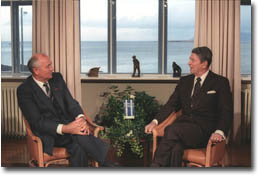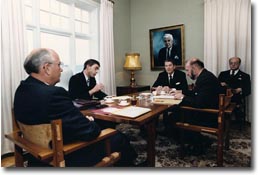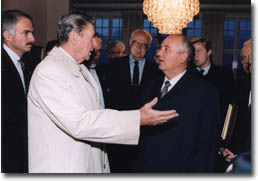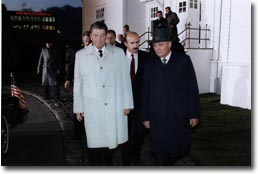Washington,
D.C. and Reykjavik, Iceland - President Ronald Reagan
and Soviet leader Mikhail Gorbachev almost achieved a deal 20
years ago at the 1986 Reykjavik summit to abolish nuclear weapons,
but the agreement would have required "an exceptional level
of trust" that neither side had yet developed, according
to previously secret U.S. and Soviet documents posted today on
the Web by the National Security Archive of George Washington
University and presented on October 12 in Reykjavik directly to
Gorbachev and the president of Iceland.
 |
| The two leaders
in conversation at Hofdi House, 11 October 1986 (Source:
Ronald Reagan Presidential Library) [Click image for
larger version.] |
|
The documents include Gorbachev's
initial letter to Reagan from 15 September 1986 asking for "a
quick one-on-one meeting, let us say in Iceland or in London,"
newly translated Gorbachev discussions with his aides and with
the Politburo preparing for the meeting, U.S. Secretary of State
George Shultz's briefing book for the summit, the complete U.S.
and Soviet transcripts of the Reykjavik summit, and the internal
recriminations and reflections by both sides after the meeting
failed to reach agreement.
Archive director Thomas Blanton,
Archive director of Russia programs Dr. Svetlana Savranskaya,
and Pulitzer-Prize-winning biographer Dr. William Taubman presented
the documents to Gorbachev at a state dinner in the residence
of President Olafur Ragnar Grimsson of Iceland on October 12 marking
the 20th anniversary of the summit, which Grimsson commented had
put Iceland on the map as a meeting place for international dialogue.
The documents show that U.S. analysis
of Gorbachev's goals for the summit completely missed the Soviet
leader's emphasis on "liquidation" of nuclear weapons,
a dream Gorbachev shared with Reagan and which the two leaders
turned to repeatedly during the intense discussions at Reykjavik
in October 1986. But the epitaph for the summit came from Soviet
aide Gyorgy Arbatov, who at one point during staff discussions
told U.S. official Paul Nitze that the U.S. proposals (continued
testing of missile defenses in the Strategic Defense Initiative
or SDI while proceeding over 10 years to eliminate all ballistic
missiles, leading to the ultimate abolition of all offensive nuclear
weapons) would require "an exceptional level of trust"
and therefore "we cannot accept your position."
 |
| Gorbachev and Reagan
during a one-on-one session at Hofdi House. U.S. Ambassador
Jack Matlock is seated to Reagan's left. (Source:
Ronald Reagan Presidential Library) [Click image for
larger version.]
|
|
Politburo notes from October 30,
two weeks after the summit, show that Gorbachev by then had largely
accepted Reagan's formulation for further SDI research, but by
that point it was too late for a deal. The Iran-Contra scandal
was about to break, causing Reagan's approval ratings to plummet
and removing key Reagan aides like national security adviser John
Poindexter, whose replacement was not interested in the ambitious
nuclear abolition dreams the two leaders shared at Reykjavik.
The documents show that even the more limited notion of abolishing
ballistic missiles foundered on opposition from the U.S. military
which presented huge estimates of needed additional conventional
spending to make up for not having the missiles.
The U.S. documents were obtained
by the Archive through Freedom of Information Act requests to
the Ronald Reagan Presidential Library and the U.S. Department
of State. The Soviet documents came to the Archive courtesy of
top Gorbachev aide Anatoly Sergeyevich Chernyaev, who has donated
his diary and notes of Politburo and other Gorbachev discussions
to the Archive, and from the Volkogonov collection of the U.S.
Library of Congress.
 |
| Reagan and Gorbachev
following a final, unscheduled session held in hopes
of reaching agreement, 12 October 1986. Soviet Ambassador
Anatoly Dobrynin (center) and Foreign Minister Eduard
Shevardnadze (far right) look on. (Source: Ronald
Reagan Presidential Library) [Click image for larger
version.]
|
|
The
Reykjavik File: Previously Secret U.S. and Soviet Documents on the
1986 Reagan-Gorbachev Summit
From the Collections of
the National Security Archive, George Washington University, Washington,
D.C., October 2006
[The U.S. documents were obtained by the
Archive through Freedom of Information Act requests
and Mandatory Declassification Review Requests to
the Ronald Reagan Presidential Library and the U.S. Department
of State. The Soviet documents came to the Archive courtesy of
top Gorbachev aide Anatoly Sergeyevich Chernyaev, who has donated
his diary and notes of Politburo and other Gorbachev discussions
to the Archive, and from the Volkogonov collection of the U.S.
Library of Congress.]
Note: The documents cited in this
Electronic Briefing Book are in PDF format. You will need to download
and install the free Adobe
Acrobat Reader to view.
Document
1: "Dear Mr. President," Mikhail Gorbachev
letter to Ronald Reagan, 15 September 1986 (unofficial translation
with signed Russian original, proposing "a quick one-on-one
meeting, let us say in Iceland or in London"), 6 pp. with
4 pp. Russian original
This letter, carried by Soviet
foreign minister Eduard Shevardnadze to Washington, initiated
the Reykjavik summit meeting when Gorbachev proposed "a
quick one-on-one meeting, let us say in Iceland or in London,"
in order to break out of the cycle of spy-versus-spy posturing
and inconclusive diplomatic negotiations after the 1985 Geneva
summit. The English translation includes underlining by Reagan
himself, who marked the sentence accusing the U.S. of deliberately
finding a "pretext" to "aggravate" relations,
and the two sentences about making "no start" on implementing
the Geneva agreements and not "an inch closer to an agreement
on arms reduction."
Document
2: USSR CC CPSU Politburo discussion of Reagan's
response to Gorbachev's initiative to meet in Reykjavik and strategic
disarmament proposals, 22 September 1986, 2 pp.
Foreign Minister Eduard Shevardnadze
reports to the Politburo on his talks in Washington and informs
the Soviet leadership about Reagan's decision to accept Gorbachev's
invitation to meet in Reykjavik on the condition that 25 Soviet
dissidents including Yury Orlov and Nicholas Daniloff, accused
of spying, are released. Gorbachev accepts the conditions and
sets forth his main ideas for the summit. The Soviet position,
according to him, should be based on acceptance of U.S. security
interests, otherwise negotiations would be unproductive. Gorbachev
is aiming at a serious improvement in U.S.-Soviet relations.
Document
3: Gorbachev discussion with assistants on preparations
for Reykjavik, 29 September 1986, 1p.
At this Politburo meeting Gorbachev
stresses once again the importance of taking U.S. interests
into account and the fact that his new policy is creating a
positive dynamic for disarmament in Europe. He emphasizes the
need for an "offensive" and the active nature of new
Soviet initiatives for Reykjavik.
Document
4: Memorandum to the President, Secretary of State
George Shultz, "Subject: Reykjavik," 2 October 1986,
4 pp.
This briefing memo from Shultz
to Reagan, labeled "Super Sensitive" as well as formally
classified as "Secret/Sensitive," shows that the U.S.
did not expect any actual agreement at Reykjavik, but rather,
mere preparations for a future summit in the U.S. Shultz talks
here about ceilings on ballistic missiles but fails to predict
Gorbachev's dramatic agreements to 50% cuts and a process leading
to the abolition of nuclear weapons. Ironically, Shultz says
one of the U.S. goals is to emphasize progress "without
permitting the impression that Reykjavik itself was a Summit,"
when history now sees Reykjavik as in many ways the most dramatic
summit meeting of the Cold War.
Document
5: Gorbachev's instructions for the group preparing
for Reykjavik, 4 October 1986, 5 pp.
Gorbachev explains his top priorities
and specific proposals to the group charged with preparing for
Reykjavik. He calls for preparing a position with a "breakthrough
potential," which would take into account U.S. interests
and put strategic weapons, not issues of nuclear testing, at
the forefront. Gorbachev's ultimate goal for Reykjavik-he reiterates
it several times during the meeting-is total liquidation of
nuclear weapons based on the Soviet 15 January 1986 Program
of Liquidation of Nuclear Weapons by the Year 2000. Whereas
Gorbachev sees the value in making concessions in hopes of achieving
a breakthrough, his Politburo colleagues (including Chebrikov)
warn him against using this word in the negotiations. In the
evening Gorbachev gives additional instructions to Chernyaev
on human rights and on the matter of Gorbachev's wife, Raisa
Maksimovna, accompanying him to Iceland.
Document
6: "Gorbachev's Goals and Tactics at Reykjavik,"
National Security Council (Stephen Sestanovich), 4 October 1986,
2 pp. (plus cover page from John M. Poindexter [National Security
Adviser to the President] to Shultz)
This briefing memo prepared (on
the same day as Gorbachev's Politburo discussion above) by one
of the National Security Council's senior Soviet experts, completely
mis-predicts Gorbachev's behavior at the Reykjavik summit. Far
from being "coy" or "undecided" about a
future U.S. summit, Gorbachev was already planning major concessions
and breakthroughs. Far from having to "smoke" Gorbachev
out during the talks, Reagan would be faced with an extraordinarily
ambitious set of possible agreements.
Document
7: "The President's Trip to Reykjavik, Iceland,
October 9-12, 1986 - Issues Checklist for the Secretary,"
U.S. Department of State, 7 October 1986, 23 pp. (first 2 sections
only, Checklist and Walk-through)
This detailed briefing book for
Secretary Shultz provides a one-stop-shopping portrait of the
state of U.S.-Soviet relations and negotiations on the eve of
the Reykjavik summit. The complete table of contents gives the
list of briefing papers and backgrounders that are also available
in the collections of the National Security Archive (from FOIA
requests to the State Department), but posted here are only
the first two sections of the briefing book: the "Checklist"
of U.S.-Soviet issues, and the "Walk-Through" of subjects
for the Reykjavik agenda. Notable is the very first item on
the latter, which presupposes that the best they will achieve
is some agreement on a number of ballistic missile warheads
between the U.S. proposal of 5500 and the Soviet proposal of
6400, rather than the radical cuts that wound up on the table
at Reykjavik.
Document
8: USSR CC CPSU Politburo session on preparations
for Reykjavik, 8 October 1986, 6 pp.
In this last Politburo session
before the delegation departed for Reykjavik, Gorbachev goes
over the final details of the Soviet proposals. He allows for
the possibility that the meeting could be a failure, and suggests
making "concessions on intermediate range missiles,"
and French and British nuclear weapons. Gorbachev believes there
should be no "intermediate" positions or agreements,
driving for his maximum program even if concessions would have
to be made. Shevardnadze sounds most optimistic predicting that
the U.S. side could agree with the Soviet non-withdrawal period
on the Anti-Ballistic Missile (ABM) treaty and on 50% cuts of
the nuclear triad (missiles, bombers, submarines) and intermediate-range
missiles.
 |
| Reagan and Gorbachev
depart Hofdi House after the conclusion of the summit,
12 October 1986. (Source: Ronald Reagan Presidential
Library) [Click image for larger version.]
|
|
Document
9: U.S. Memorandum of Conversation, Reagan-Gorbachev,
First Meeting, 11 October 1986, 10:40 a.m. - 12:30 p.m., 8 pp.
Document
10: Russian transcript of Reagan-Gorbachev Summit
in Reykjavik, 11 October 1986 (morning), published in FBIS-USR-93-061,
17 May 1993, 5 pp.
Document
11: U.S. Memorandum of Conversation, Reagan-Gorbachev,
Second Meeting, 11 October 1986, 3:30 p.m. - 5:40 p.m., 15 pp.
Document
12: Russian transcript of Reagan-Gorbachev Summit
in Reykjavik, 11 October 1986 (afternoon), published in FBIS-USR-93-087,
12 July 1993, 6 pp.
Document
13: U.S. Memorandum of Conversation, Reagan-Gorbachev,
Third Meeting, 12 October 1986, 10:00 a.m. - 1:35 p.m., 21 pp.
Document
14: Russian transcript of Reagan-Gorbachev Summit
in Reykjavik, 12 October 1986 (morning), published in FBIS-USR-93-113,
30 August 1993, 11 pp.
Document
15: U.S. Memorandum of Conversation, Reagan-Gorbachev,
Final Meeting, 12 October 1986, 3:25 p.m. - 4:30 p.m. and 5:30
p.m. - 6:50 p.m., 16 pp.
Document
16: Russian transcript of Reagan-Gorbachev Summit
in Reykjavik, 12 October 1986 (afternoon), published in FBIS-USR-93-121,
20 September 1993, 7 pp.
This side-by-side presentation
of the official U.S. transcripts of the Reykjavik summit meetings
and the Soviet transcripts as published in Moscow in 1993 and
translated by the U.S. government's Foreign Broadcast Information
Service puts the reader inside the bullet-proof glass over the
windows of Hofdi House as Reagan, Gorbachev, their translators,
and their foreign ministers discuss radical changes in both
U.S. and Soviet national security thinking.
The two sets of transcripts are
remarkably congruent, with each version providing slightly different
wording and detail but no direct contradictions. Reagan and
Gorbachev eloquently express their shared vision of nuclear
abolition, and heatedly debate their widely divergent views
of missile defenses. For Reagan, SDI was the ultimate insurance
policy against a madman blackmailing the world with nuclear-tipped
missiles in a future where all the superpowers' missiles and
nuclear weapons had been destroyed. Reagan comes back again
and again to the metaphor of keeping your gas masks even after
banning chemical weapons, but Gorbachev feels as if Reagan is
lecturing him, and says "that's the 10th time you talked
about gas masks."
For Gorbachev, SDI was a U.S.
attempt to take the arms race into space and potentially launch
a first-strike attack on the Soviet Union - the ultimate nightmare
for Soviet leaders seared into their consciousnesses by Hitler's
blitzkrieg. But Gorbachev's scientists had already told him
that missile defenses could be easily and cheaply countered
with multiple warheads and decoys even if the defenses ever
worked (which was unlikely).
The great "what if"
question suggested by the Reykjavik transcripts is what would
have happened if Gorbachev had simply accepted Reagan's apparently
sincere offer to share SDI technology rather than dismissing
this as ridiculous when the U.S. would not even share "milking
machines." If Gorbachev had "pocketed" Reagan's
offer, then the pressure would have been on the U.S. to deliver,
in the face of a probable firestorm of opposition from the U.S.
military and foreign policy establishment. Working in the opposite
direction in favor of the deal would have been overwhelming
public support for these dramatic changes, both in the U.S.
and in the Soviet Union, and especially in Europe.
Perhaps most evocative is the
Russian version's closing words, which are not included in the
U.S. transcript. This exchange comes after Reagan asks for a
personal "favor" from Gorbachev of accepting the offer
on SDI and ABM, and Gorbachev replies by saying this is not
a favor but a matter of principle. The U.S. version has Reagan
standing at that point to leave the room and a brief polite
exchange about regards to Nancy Reagan. But the Russian version
has Reagan saying, "I think you didn't want to achieve
an agreement anyway" and "I don't know when we'll
ever have another chance like this and whether we will meet
soon."
Document
17: Russian transcript of Negotiations in the Working
Group on Military Issues, headed by Nitze and Akhromeev, 11-12
October 1986, 52 pp.
In the all-night negotiations
of Soviet and U.S. military experts during the middle of the
Reykjavik summit, the Soviet delegation led by Marshal Sergei
Akhromeev starts from the new Soviet program, just outlined
by Gorbachev in his meeting with Reagan earlier in the day-proposing
50% cuts of strategic weapons across the board, a zero option
on intermediate-range missiles in Europe, and a 10-year period
of non-withdrawal from the ABM treaty. At the same time, the
U.S. delegation led by Paul Nitze conducts the discussion practically
disregarding the new Soviet proposals and negotiating on the
basis of U.S. proposals of 18 January 1986, which by now are
overtaken by the latest developments in the Reagan-Gorbachev
talks. Responding to U.S. proposals on allowing development
of SDI while proceeding with deep cuts in strategic weapons,
member of the Soviet delegation Georgy Arbatov comments "what
you are offering requires an exceptional level of trust. We
cannot accept your position," directly implying that the
necessary level of trust was not there. This document, prepared
as a result of the all-night discussion, outlined the disagreements
but failed to integrate the understandings achieved by the two
leaders on October 11 or approached again on October 12.
Document
18: "Lessons of Reykjavik," U.S. Department
of State, c. 12 October 1986, 1 p. (plus cover sheet from Shultz
briefing book for media events October 17, but text seems to have
been written on last day of summit, October 12)
This remarkable one-page summary
of the summit's lessons seems to have been written on the last
day of Reykjavik, given the mention of "today's" discussions,
but leaves a dramatically positive view of the summit in contrast
to the leaders' faces as they left Hofdi House, as well as to
Shultz's downbeat presentation at the press briefing immediately
following the summit. It is unclear who authored this document,
although the text says that "I have been pointing out these
advantages [of thinking big] in a theoretical sense for some
time." This document plus Gorbachev's own very positive
press briefing commentary immediately following the summit were
included in Secretary Shultz's briefing book for his subsequent
media appearances.
Document
19: Gorbachev's reflections on Reykjavik on the flight
to Moscow, 12 October 1986, 2 pp.
In his remarks on the way back
from Reykjavik, written down by Chernyaev, Gorbachev gives a
very positive assessment of the summit. He proclaims that he
is now "even more of an optimist after Reykjavik,"
that he understood Reagan's domestic problems and that the U.S.
President was not completely free in making his decisions. He
understands Reykjavik as signifying a new stage in the process
of disarmament-from limitations to total abolition.
Document
20: "Iceland Chronology," U.S. Department
of State, 14 October 1986, 11 pp.
This blow-by-blow, minute-by-minute
chronology sums up not only the discussions given in detail
in the transcripts above, but also all the preparatory meetings
and discussions and logistics on the U.S. side.
Document
21: USSR CC CPSU Politburo session on results of
the Reykjavik Summit, 14 October 1986, 12 pp.
In the first Politburo meeting
after Reykjavik, Gorbachev reports on the results, starting
with a standard ideological criticism of Reagan as a class enemy
who showed "extreme primitivism, a caveman outlook and
intellectual impotence." He goes on, however, to describe
the summit as a breakthrough, and the attainment of a new "higher
level from which now we have to begin a struggle for liquidation
and complete ban on nuclear armaments." The Politburo agrees
with the assessment and approves the General Secretary's tough
posturing.
Document
22: USSR CC CPSU Politburo session on measures in
connection with the expulsion of Soviet diplomats from the USA,
22 October 1986, 2 pp.
Reacting to the U.S. decision
to expel Soviet diplomats, the Politburo discusses the perceived
American retreat from the understandings reached at Reykjavik
and decides to press Reagan to follow through with the disarmament
agenda on the basis of the summit.
Document
23: USSR CC CPSU Politburo session. Reykjavik assessment
and instructions for Soviet delegation for negotiations in Geneva,
30 October 1986, 5 pp.
At this Politburo session Gorbachev
and Shevardnadze discuss whether and when to reveal the new
Soviet position on SDI testing, which would allow "testing
in the air, on the test sites on the ground, but not in space."
This is a significant step in the direction of the U.S. position
and is seen as a serious concession on the Soviet part by Foreign
Minister Gromyko. Gorbachev is very concerned that the U.S.
administration is "perverting and revising Reykjavik, retreating
from it." He places a great deal of hope in Shevardnadze-Shultz
talks in terms of returning to and expanding the Reykjavik agenda.
Document
24: Memorandum for the President, John M. Poindexter,
"Subject: Guidance for Post-Reykjavik Follow-up Activities,"
1 November 1986, 1 p.
This cover memo describes the
process of developing National Security Decision Directive 250
(next document) on Post-Reykjavik follow-up, led by National
Security Adviser John Poindexter. The most striking aspect of
this memo is Poindexter's own claim that he has incorporated
as much as he can (accounting for the President's expressed
bottom lines) of the Pentagon's and other objections, and that
he needs to brief Reagan about remaining objections on matters
that simply would not fit with the President's program.
Document
25: National Security Decision Directive Number 250,
"Post-Reykjavik Follow-Up," 3 November 1986 (signed
by Ronald Reagan), 14 pp.
Largely the work of NSC staffer
Robert Linhard, who participated at Reykjavik, NSDD 250 attempts
to keep the U.S. national security bureaucracy focused on President
Reagan's goal of eliminating ballistic missiles while walking
back from Reagan's expressed intent at Reykjavik to eliminate
all offensive nuclear weapons. In fact, the NSDD's version of
Reykjavik completely leaves out the Reagan and Shultz statements
to Gorbachev about welcoming the abolition of nuclear weapons.
Yet even this limited effort did not succeed in moving the U.S.
bureaucracy towards realistic planning, and in fact the Joint
Chiefs of Staff promptly weighed in with National Security Adviser
Poindexter to the effect that eliminating missiles would require
large increases in conventional military spending.
Document
26: USSR CC CPSU Politburo session. About discussions
between Shevardnadze and Shultz in Vienna, 13 November 1986, 3
pp.
Here the Politburo discusses
the results of the Shevardnadze-Shultz talks in Geneva, where
Shultz refused to discuss new Shevardnadze's proposals concerning
what is allowed and not allowed under the ABM treaty. Shultz's
position notwithstanding, Gorbachev emphasizes the need to press
the U.S. to move forward on the basis of Reykjavik. Gorbachev
stresses that "we have not yet truly understood what Reykjavik
means," referring to its significance as a new level of
disarmament dialogue.
Document
27: Gorbachev Conversation with Chernyaev about Reykjavik,
17 November 1986, 1 p.
In a conversation with Chernyaev,
Gorbachev talks about Soviet next steps in countering the U.S.
attempts to circumvent Reykjavik. He stresses that "we
cannot go below Reykjavik," and is concerned that "the
Americans will not go above Reykjavik."
Document
28: Gorbachev Conference with Politburo Members and
Secretaries of the Central Committee, 1 December 1986, 4 pp.
In a Politburo discussion of
the Reagan decision to abandon the SALT II treaty, Gorbachev
angrily states that the Americans are not doing anything in
the spirit of Reykjavik and that the recent position of the
Reagan administration was related to the domestic political
crisis over Iran-Contra. Yegor Ligachev agrees with Gorbachev
that after Reykjavik the Soviet positions only became stronger.
Gorbachev speaks about his awareness of growing opposition to
his disarmament proposals among the generals, who are "hissing
among themselves."
Document
29: Meeting with the Joint Chiefs of Staff, Alton
G. Keel [Executive Secretary of the National Security Council],
18 December 1986 [for meeting on 19 December to discuss NSDD 250
and other topics], 7 pp. with staff attachments and talking points
This set of documents demonstrates
how the proposals on the table at Reykjavik had fallen off the
table in Washington after the Iran-Contra scandal and Poindexter's
departure, and as the result of the U.S. military's opposition.
NSC senior staffer Alton Keel sets up an agenda for President
Reagan's meeting with the Joint Chiefs of Staff that includes
the elimination of ballistic missiles together with routine
briefings about military exercises and anti-drug efforts in
Bolivia, and alerts the President to the military's insistence
on large spending increases. But he does not forward the striking
talking points prepared by the NSC staff (under Poindexter)
that would have expressed to the top U.S. military what Reagan
had said at Reykjavik to Gorbachev.

